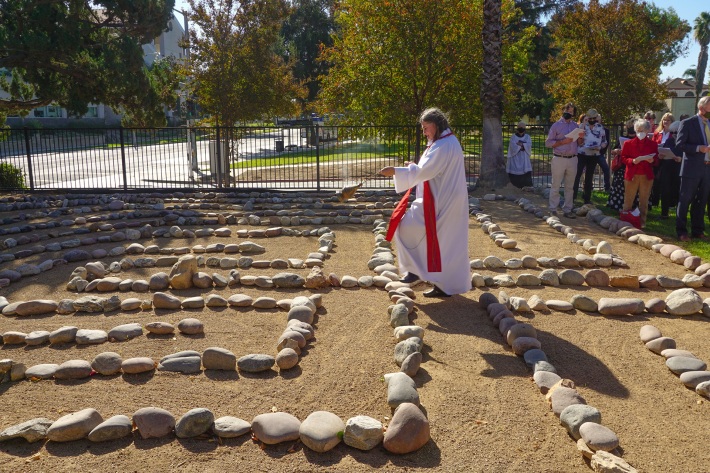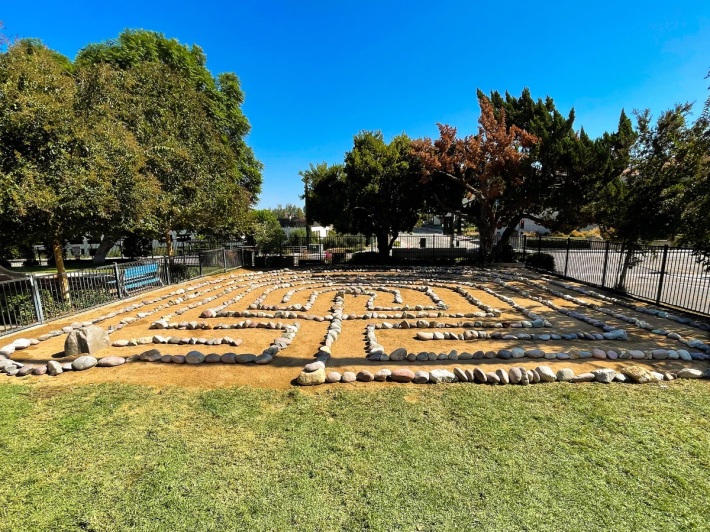16,000 Cardboard Spoons Highlight Child Hunger Crisis
La Sierra University art installation turns macaroni boxes into powerful statement on food insecurity.
Rich in their history and purpose, Mother Kelli Grace Kurt says labyrinths invite people to 'experience their souls.'

The staff and congregation at All Saints’ Episcopal Church in Riverside celebrated the dedication of its first prayer labyrinth alongside members of the community during a formal visit from its bishop.
Opening Sunday’s high Mass, Bishop John H. Taylor of the Episcopal Diocese of Los Angeles gave confirmation to 18 church adults. After the 10 a.m. service folks made their way to the front lawn where Taylor then blessed the massive rock labyrinth with holy water, followed by an afternoon reception.
“It’s very glorious, it’s dignified, it’s beautiful,” said the Reverend Canon Kelli Grace Kurtz of the special day event.

Outside the church, which is located on the corner of Terracina Drive and Magnolia Avenue, members and acolytes dressed in regal white robes gathered around. Prayers were offered before the labyrinth and together the approximate 150 attendees recited a litany asking God to be present to their worries, joys and fears. A marker on the site says, “Dedicated to the glory of God and in thanksgiving for God’s care during the pandemic of 2020–2021.”
The seven circuit labyrinth, which circumferences 50 feet by 50 feet, began as a surprise gift idea from the congregation to Kurtz — to celebrate both her birthday and two-year anniversary at the church — this past March. Kurtz said everyone pitched in different sized rocks and boulders from the beach, from rivers and their backyards with the intention to build a labyrinth that would symbolize All Saints’ collective hope coming out of darkness and out of the divisiveness of the COVID-19 pandemic. (Labyrinths can be made of other materials, like grass, shrubs, tiles, etc. Kurtz pointed out.)
“It was very, very hard work but it was sacred work. We built something that is forward-facing and then something that we can say, ‘God has gotten us through these hard times,’” Kurtz said.
Despite an uptick in community homelessness, the labyrinth will remain open to the public since it “ truly is a gift to the entire [Riverside] community” to utilize not just for the church vestry.
“It’s not just about the Episcopal Church, nor is it about Christianity specifically. But it’s a spiritual path toward wholeness, toward centeredness. We’re delighted to be able to offer this to the community,” Kurtz said.

Although uniquely intricate in their diverse patterns, the circular — or sometimes square and oblong — structures are not to be confused with mazes. Where a maze is designed with multiple entrances generally to confuse, Kurtz said labyrinths, whether placed indoors or outside, are made to have only one opening which always leads to the center.
“There’s never someone that jumps out and scares you. You can’t get lost,” she said.
Labyrinths are variously sized walking paths, and are “sort of akin to a guided meditation,” said Lindy Collaluca-Polling, the assistant to Kurtz and All Saints’ digital manager and program manager.
Why a person may choose to walk a labyrinth and how that person decides to interact with it however, — whether alone or with a group — is entirely their prerogative. It could be that a person needs to let go of a troubling experience or it can be as simple as giving thanks for life’s blessings. Polling, who has walked labyrinths for all long as she can remember, said she’s found herself going back to them whenever she feels frustrated and overwhelmed.
“If I’m all shaken up like a snowball, by the time I get done with the labyrinth everything is settled out,” she said.
Some prayer-walking experiences may include peaceful music where others encourage remote silence. Either way, a labyrinth’s primary purpose is to help the person slow down and focus on what they can see, hear and smell. Kurtz said people should even take the opportunity to walk labyrinths barefoot.
“I usually invite people to walk slowly and intentionally — to think about those things that you want to release: burdens, regrets and all the stuff that weighs you down and prevents you from living fully,” she said.
Labyrinths are meant to evoke strength, healing, forgiveness “and the sense of mercy and justice.” When people exit them, they will leave with “renewed energy, a sense of renewed courage” and a greater sense of clarity, Kurtz, who first walked a labyrinth in the early 1980’s, said.
Kurtz was ordained a priest 25 years ago after serving as All Saints’ deacon. She completed her associate work at All Saints’ as its associate clergy person from 1999 to 2007. The next 12 years Kurtz led a congregation in La Verne, California, where she built one of two other labyrinths, and in February 2019 was elected back as rector at All Saints’.
Over the years, Kurtz said her interaction with labyrinths has not necessarily become easier but that she better understands their purpose and sees labyrinths as the “outward marking of the recommitment” to all spiritual disciplines.
“I trust it now much more than I did before,” she said.
Labyrinths and the ancient form of sacred walking — predating Christianity — are found in almost all cultures around the world, according to Kurtz, including churches in Europe, parts of Africa and in Buddhism. Early Chritstians however, she said, began using labyrinths in churches as replicas of pilgrimage when they couldn’t assemble the journey to Jerusalem, a holy site for Christian believers. Essentially, the merit of walking a labyrinth became equated to embarking on a religious crusade.
Kurtz has accomplished multiple pilgrimages of her own. Four times she completed the Holy Land Pilgrimage and in 2014 trekked the Way of St. James (locally known as Camino de Santiago), a 500-mile hike in Spain which takes 35 consecutive days to finish, give or take, she said.
Over time, the use of labyrinths were slowly integrated into Espicopalian traditions for their focal target on the body, mind, and spirit. They became a way for the Episcopal Church to center on creation by uniting people to God.
As liturgical and full-experience type people “labyrinths just kind of tend to fit in nicely with our spirituality,” Kurtz said.
Labyrinths themselves, however, are not religious in nature but rather seen as spiritual tools used in both the religious and secular movements. Although widely found in some churches, the patterns are seen on college campuses and at numerous spiritual retreats.
However they are used, Kurtz said she is looking forward to seeing Riversiders come and enjoy All Saints’ labyrinth and see how they may be transformed through the practice.
“I hope people give themselves permission to experience it — to experience their souls, their spirits catching up with their bodies,” she said.
Let us email you Riverside's news and events every Sunday, Monday, Wednesday, and Friday morning. For free